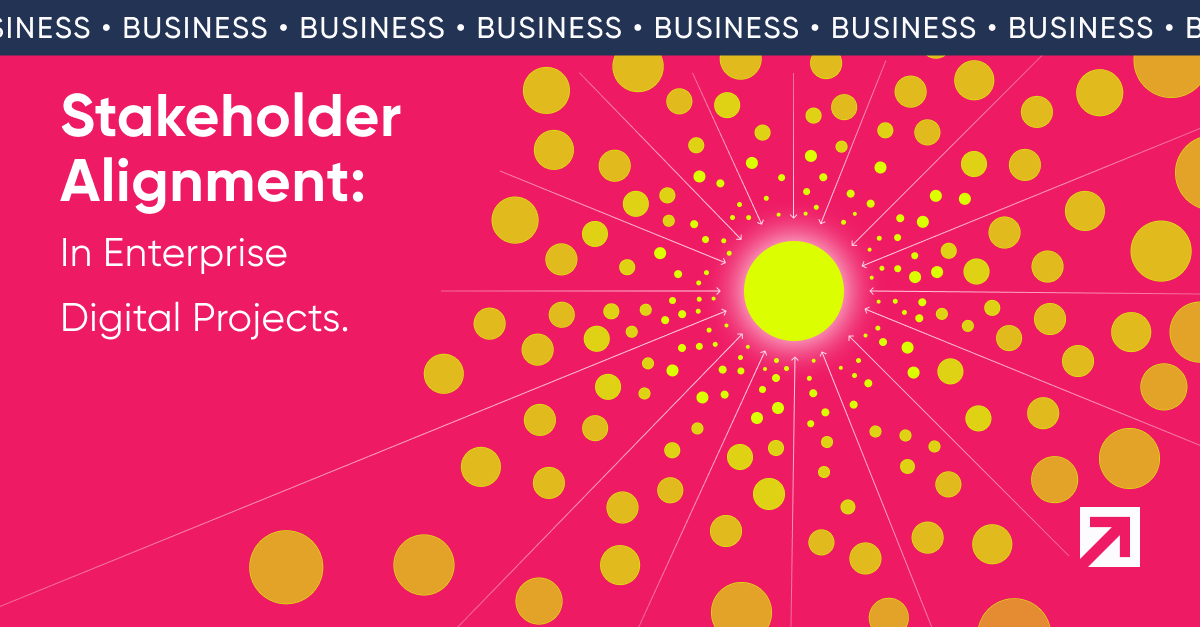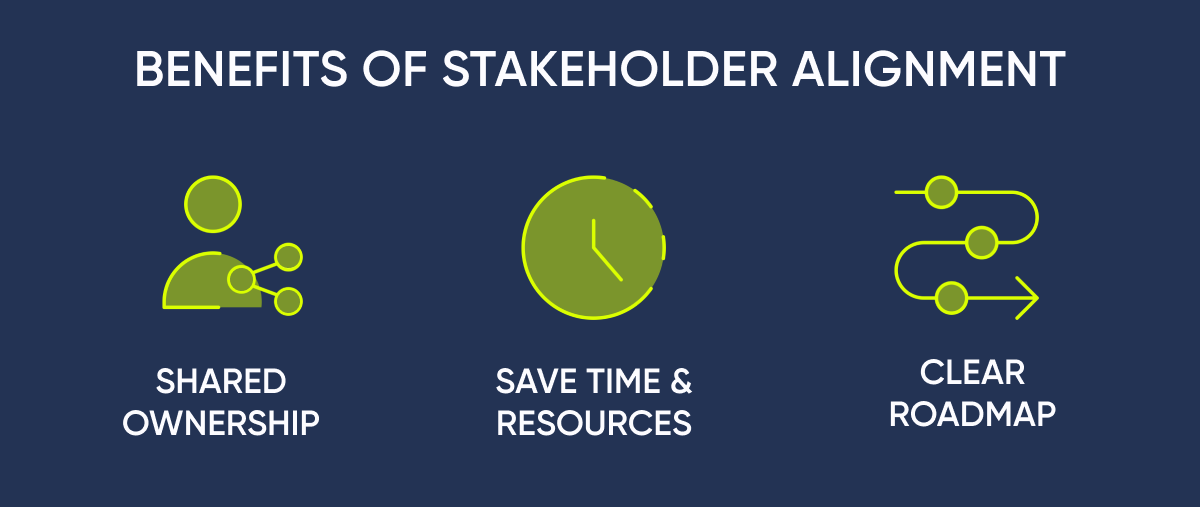
In the dynamic world of digital projects within enterprises, the intricacies of stakeholder collaboration serve as a compass, guiding ventures toward success. As the heartbeat of organizational initiatives, stakeholders bring diverse perspectives, making alignment a strategic imperative. This blog delves into the landscape of stakeholder alignment in enterprise digital projects, unraveling the complexities, challenges, and strategic methodologies.
Stakeholder Alignment
Understanding Stakeholders in the Enterprise Context
According to Investopedia, a stakeholder is "a person or group with interest in an enterprise.” But if something distinguishes enterprises, it’s the abundance of those.
Stakeholders can be either external (customers, suppliers, investors, or even competitors) or internal to an organization (employees, management, the board of directors, etc.). In this case, we're focusing on internal stakeholders, particularly those related to a specific project, venture, or product within a company. This often means team leaders, their managers, technical leaders, and the team itself. Internal stakeholders play a crucial role as the effectiveness of a business's operations hinges on their collaboration towards the goals of the business or its products.
In companies with many stakeholders (enterprises), a prevailing issue is the potential lack of alignment among diverse stakeholder interests. In some cases, these interests may even be in direct conflict.
The Crucial Role of Stakeholder Alignment
A shared concept, no matter how grand or ingenious, only takes you part of the way. Agreement on an overarching idea can mask disagreements on crucial elements—what are our objectives, and what's the most effective path to achieve them? Unraveling these differences is essential, no matter how challenging the task.
This need becomes even more pronounced with the emergence of new stakeholders from various parts of the organization. Stakeholder alignment isn't just about reaching a consensus; it's the process of shaping that consensus.
Engaging internal stakeholders early in a project is key; it enables them to track progress, fosters a sense of shared ownership, and generates momentum that draws others in as the initiative unfolds.
Mitigating the Risks of Stakeholder Misalignment
Ensuring strong stakeholder alignment in projects is not just a matter of smooth sailing; it directly influences the speed at which products reach the market. However, this journey has its challenges, especially when attempting to secure trust and buy-in for your roadmap.
The task becomes more challenging as the size of your organization increases, transforming alignment into an uphill battle. This uphill battle is not merely a metaphor; it reflects the organizational tension created when stakeholders fail to align around the core principles of a problem or strategy early in the process.
Each subsequent decision downstream becomes a potential source of friction, hindering delivery speed and increasing the risk of introducing the wrong product or feature to the market. Lack of alignment emerges as one of the most significant frustrations, leading to organizational inefficiencies and a sense of disconnection.
Strategies for Ensuring Stakeholder Alignment in Digital Projects
Enterprise vs. Startups
Although a critical aspect for both, stakeholder alignment unfolds against the backdrop of their inherent differences. Enterprises, are faced with the complexity of aligning diverse interests across various departments. Formalized processes, an established organizational culture, and the presence of legacy systems add layers to the challenge.
Startups, on the other hand, operate within a landscape marked by agility and flexibility. With leaner teams and streamlined decision-making, they can often achieve stakeholder alignment more swiftly. However, the dynamism inherent to the startup environment needs a dynamic approach to stakeholder alignment as ventures evolve their strategies, products, and market positions more rapidly.
When it comes to working with specific digital products, there are other differences to contemplate. Many startups that have come to us are in their early stage and need to do deeper work on aligning the stakeholders on key factors like the company's vision, their main business strategy, or the market placement they want to reach. Enterprises already have a well-defined vision and only need to focus on aligning their views for a specific product or service line. The debates center around use cases and features, not business objectives or long-term company visions.
Inception Decks: Shaping Clarity in Enterprise Ventures
In navigating new projects, enterprises benefit from the inception deck methodology. This approach involves aligning stakeholders through focused discussions on project characteristics. Through interactive meetings, parameters are defined regarding project concepts. This includes clarifying objectives, crafting elevator pitches, and distinctly identifying what the project is and isn't. Additionally, the inception deck addresses team composition, technical solutions, concerns, sacrifices, and preferences—ultimately shaping a concise document that elucidates priorities and choices.
Benefits of Stakeholder Alignment
In our years of experience, we have find that projects that begin with these types of exercise to ensure stakeholer alignment, usually run smoother than those who don't. We have already explained the reasons why alignment is important, especially among large, enterprise-y teams. But how does having this sort of clear, strategic document actually reflect in reality?

Shared Ownership: Upholding Transparency and Legitimacy
During the team sessions described above, we make sure all stakeholders are present to uphold clarity and transparency and provide the end result with a certain legitimacy backed by everyone present. This also makes them and us accountable to uphold what was agreed upon instead of going back and forth with what they want and who's responsible for XYZ, which brings us to the next point.
Saving Time and Resources: Accelerating Product Delivery
An effective alignment among stakeholders leads to a more rapid delivery of products to the market. This is especially true when companies are developing digital products through agile methodologies, in which is key to find the right balance between detailed upfront requirements and the flexibility for feedback and changes during regular showcases.
A Clear Roadmap: Forging a Strategic Path
A strategic alignment plan, born from exercises like the inception deck, lays the foundation for a clear roadmap. Balancing specificity and generality, this plan defines and shapes the project's objectives, becoming an instrumental guide towards timely and successful project deliveries.
Conclusion
When dealing with large teams, stakeholder alignment is a defining element for successful projects. This entails not only understanding the multitude of internal stakeholders but actively shaping consensus through strategic methodologies like inception decks.
Mitigating the risks of misalignment proves vital, as the ripple effects impact product delivery speed and organizational cohesion. However, the benefits are profound—from shared ownership and accelerated timelines to the forging of a clear roadmap.
As enterprises navigate the intricate terrain of digital initiatives, the collaborative synergy achieved through stakeholder alignment becomes the key to unlocking success in the ever-evolving landscape of digital innovation.
If you're looking for smooth collaborations defined by team sinergy or are looking to define a specific tech problem within your organization, don't hesitate to reach our team!
Thanks for reading 😊
